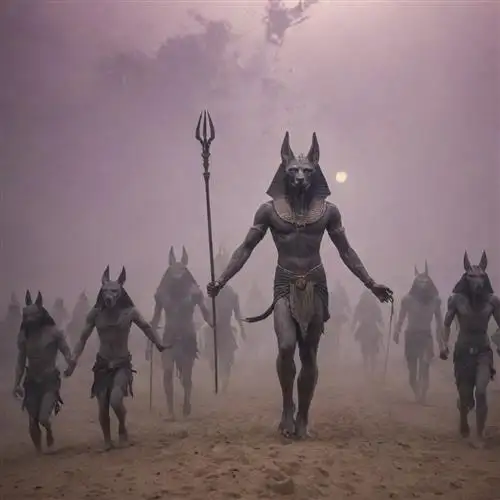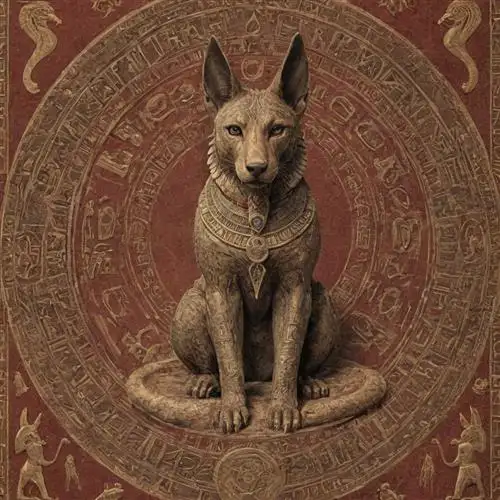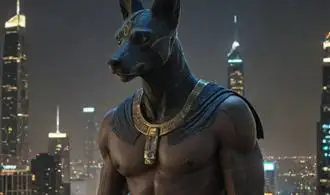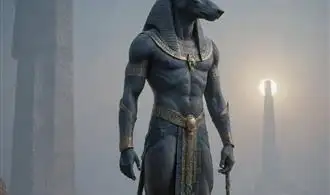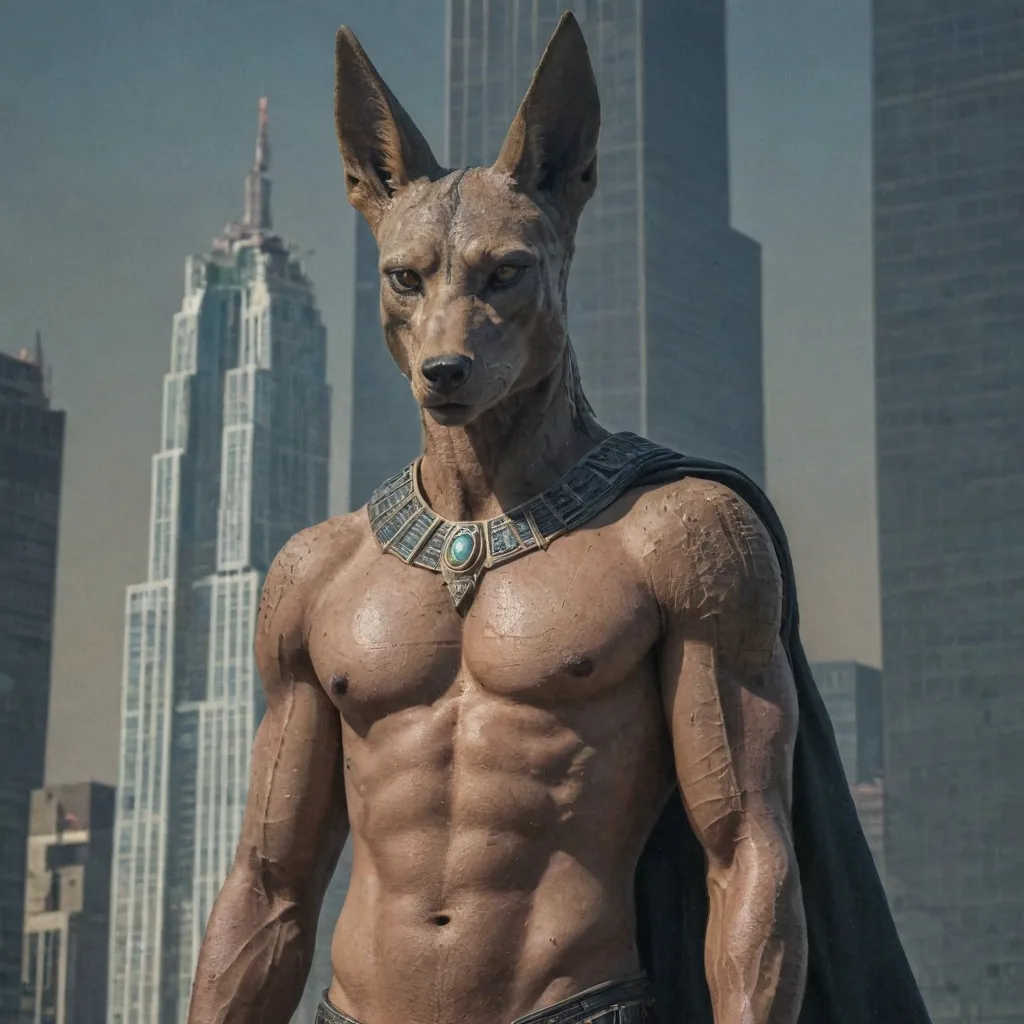
The Origins of Anubis
Anubis, the enigmatic jackal-headed deity, has captivated the minds of scholars and enthusiasts alike for centuries. Believed to be one of the oldest gods in the ancient Egyptian pantheon, Anubis' origins can be traced back to the predynastic period, where he emerged as a significant figure in the realm of funerary rituals and the afterlife.
One of the earliest known references to Anubis can be found in the Coffin Texts, a collection of ancient Egyptian funerary texts dating back to the Middle Kingdom. These texts depict Anubis as the guardian of the dead, responsible for the embalming process and the protection of the deceased during their journey to the afterlife.
The name "Anubis" is derived from the ancient Egyptian word "Anpu," which may have been a reference to the jackal, a scavenger animal known to frequent cemeteries and burial sites. This association with the jackal likely contributed to Anubis' role as the god of the dead and the embalming process, as these animals were often seen near the deceased.
In the later periods of ancient Egyptian history, Anubis' significance and iconography continued to evolve. He became closely associated with the mummification process, with Anubis overseeing the crucial steps of removing the internal organs, drying the body, and wrapping it in linen. This intimate connection with the afterlife and the preservation of the physical form cemented Anubis' status as a pivotal figure in the Egyptian belief system.
Interestingly, Anubis also played a role in the weighing of the heart ritual, a critical component of the ancient Egyptian concept of the afterlife. During this ceremony, the heart of the deceased was weighed against the feather of truth, and Anubis was responsible for overseeing this process, ensuring the accuracy of the judgment.
The iconography of Anubis further reflects his multifaceted nature. Depicted with the head of a jackal or a dog, Anubis was often shown standing or seated, holding a was-scepter (a symbol of power) or the crook and flail (emblems of royal authority). These visual representations not only highlight Anubis' role as a funerary deity but also suggest his association with kingship and authority.
Anubis Guides the Dead
Anubis, the enigmatic jackal-headed Egyptian god, holds a profoundly significant role in the afterlife journey of the deceased. As the god of embalming and the protector of the dead, Anubis is responsible for guiding the souls of the departed through the treacherous landscape of the underworld, ensuring their safe passage to the realm of eternal rest.
The primary duty of Anubis is to preside over the mummification process, a sacred ritual that prepares the deceased for the afterlife. The jackal-headed deity meticulously oversees the removal of the internal organs, the wrapping of the body in linen, and the placement of sacred amulets and talismans. This meticulous attention to detail is crucial, as any misstep during the mummification process could jeopardize the soul's journey to the afterlife.
Once the mummification is complete, Anubis assumes the role of the psychopomp, the divine being responsible for escorting the soul to the underworld. In this capacity, Anubis guides the deceased through the perilous trials and challenges that await them, offering protection and support along the way.
One of the most significant rites overseen by Anubis is the "Weighing of the Heart" ceremony, where the deceased's heart is weighed against the feather of Ma'at, the goddess of truth and justice. If the heart is found to be pure and righteous, the soul is granted passage to the realm of the afterlife. However, if the heart is found wanting, the soul is devoured by the fearsome creature Ammut, the Devourer of Souls.
Anubis's role as a guide and protector extends beyond the initial journey into the underworld. The jackal-headed god is believed to be present at the judgment of the dead, offering counsel and support to the deceased as they face the final reckoning. Additionally, Anubis is often depicted standing vigil over the deceased, ensuring their safety and guiding their spirit to the afterlife.
Symbols and Iconography of Anubis
Anubis, the enigmatic jackal-headed god of ancient Egypt, is renowned for his rich symbolism and captivating iconography. As one of the most prominent deities in the Egyptian pantheon, Anubis' visual representation holds profound significance, shedding light on his multifaceted role and the profound beliefs surrounding him.
At the core of Anubis' iconography is the jackal or wild dog, which serves as his primary depiction. The jackal was a revered creature in ancient Egyptian culture, associated with the desert, death, and the afterlife. Anubis' jackal-headed form reflects his role as the guardian of the dead, overseeing the crucial process of mummification and the journey to the afterlife.
The color black is strongly linked to Anubis, symbolizing both the color of the fertile soil along the Nile and the color of the decomposing bodies that Anubis oversees. This connection to the life-giving and death-dealing aspects of the natural world underscores Anubis' position as a deity of immense power and importance.
Anubis is often portrayed holding a variety of symbolic objects, each imbued with deep meaning. The was scepter, a symbol of power and authority, is frequently depicted in Anubis' hands, representing his role as a guiding force in the afterlife. The ankh, the ancient Egyptian symbol of life, is also associated with Anubis, signifying his ability to bridge the gap between the realms of the living and the dead.
Another iconic symbol linked to Anubis is the golden scale, which he uses to weigh the deceased's heart against the feather of truth during the judgment of the dead. This weighing process, known as the "Weighing of the Heart," is a pivotal moment in the Egyptian afterlife, and Anubis' presence as the overseer of this ritual underscores his importance in the journey to the afterworld.
The jackal-headed god's iconography also includes the depiction of Anubis laying on a funeral bier, guarding the mummified body of the deceased. This representation highlights Anubis' role as the protector of the dead, ensuring a safe passage to the afterlife.
In addition to his primary jackal-headed form, Anubis is also sometimes portrayed as a fully anthropomorphic figure, with a human body and a jackal head. This variation in his iconography reflects the multifaceted nature of the deity, encompassing both his human and animal aspects.
The Cult of Anubis
Anubis, the enigmatic jackal-headed deity, has captivated the minds of scholars and enthusiasts alike for millennia. At the heart of this fascination lies the intricate tapestry of the Cult of Anubis, a devotional following that has endured through the ages. This cult, rooted in the ancient Egyptian pantheon, offers a glimpse into the profound reverence and mysticism surrounding this revered figure.
The origins of the Cult of Anubis can be traced back to the earliest dynastic periods of ancient Egypt. Anubis, the god of embalming and the afterlife, was believed to guide the deceased through the complex and perilous journey of the underworld. This critical role in the funerary rites and the eternal journey of the soul cemented Anubis' place as a central figure in the Egyptian religious landscape.
The cult's devotees viewed Anubis as the gatekeeper to the afterlife, the one who weighed the hearts of the deceased against the feather of Ma'at, the goddess of truth and justice. This divine judgment determined the fate of the soul, and the cult's adherents sought Anubis' favor and protection to ensure a successful transition into the next realm.
The rituals and practices of the Cult of Anubis were intricate and multifaceted. Worshippers would offer prayers, make offerings, and engage in ceremonial rites to invoke Anubis' blessings. The cult's most prominent centers were located in Abydos and Cynopolis, where the god's sacred temples and shrines attracted pilgrims from across the ancient Egyptian world.
Beyond the formal religious practices, the Cult of Anubis also wove its way into the fabric of everyday life. Amulets and talismans bearing the image of Anubis were worn as protective charms, believed to provide guidance and safeguard the wearer on their journey through life and death.
The influence of the Cult of Anubis extended beyond the realm of the living, manifesting in the elaborate funerary practices and mummification rituals that were central to ancient Egyptian culture. The jackal-headed god was integral to the embalming process, overseeing the preservation of the physical body and preparing the deceased for their eternal existence.
The reverence for Anubis was not limited to the ancient Egyptians alone. The cult's influence also spread to the Greco-Roman world, where the god was syncretized with deities such as Hermes and Cerberus, further expanding the god's reach and significance.
Anubis in Modern Mythology
Anubis, the enigmatic jackal-headed god of ancient Egypt, has captivated the imagination of modern enthusiasts and scholars alike. In the realm of modern mythology, this ancient deity continues to hold sway, commanding reverence and intrigue from those drawn to the mystique of the Egyptian pantheon. Delving into the depths of Anubis' enduring presence in contemporary culture, we uncover a tapestry of beliefs, interpretations, and adaptations that showcase the resilience of this once-revered figure.
At the heart of Anubis' modern mythos lies a profound connection to the afterlife and the rituals that guided the deceased on their final journey. In the diverse realms of literature, film, and occult practices, Anubis has been reimagined and reinterpreted, often serving as a guide, protector, or harbinger of the transition between the mortal and the divine. From the pages of urban fantasy novels to the silver screen, Anubis has been imbued with a captivating duality, embodying both the solemn responsibilities of the underworld and the allure of the arcane.
One particularly intriguing aspect of Anubis' modern manifestation is his association with the concept of the "shadow self." In Jungian psychology and esoteric traditions, Anubis is often seen as a symbol of the subconscious, the hidden aspects of the human psyche that yearn to be explored and integrated. This perspective has given rise to a wealth of interpretations, with Anubis serving as a guide and facilitator in the journey of self-discovery and spiritual transformation.
Furthermore, Anubis' role as a deity of mummification and preservation has found resonance in the modern world, where his influence can be seen in the proliferation of interest in ancient Egyptian practices and the preservation of cultural heritage. From the meticulous reconstruction of ancient rituals to the conservation of archaeological sites, Anubis' legacy continues to shape the ways in which we engage with and honor the past.


